Carya illinoinensis
Whether you pronounce it correctly as puh-KAHNS or erroneously as PEE-cans, there’s no denying the aesthetic, nut-producing power of pecans.
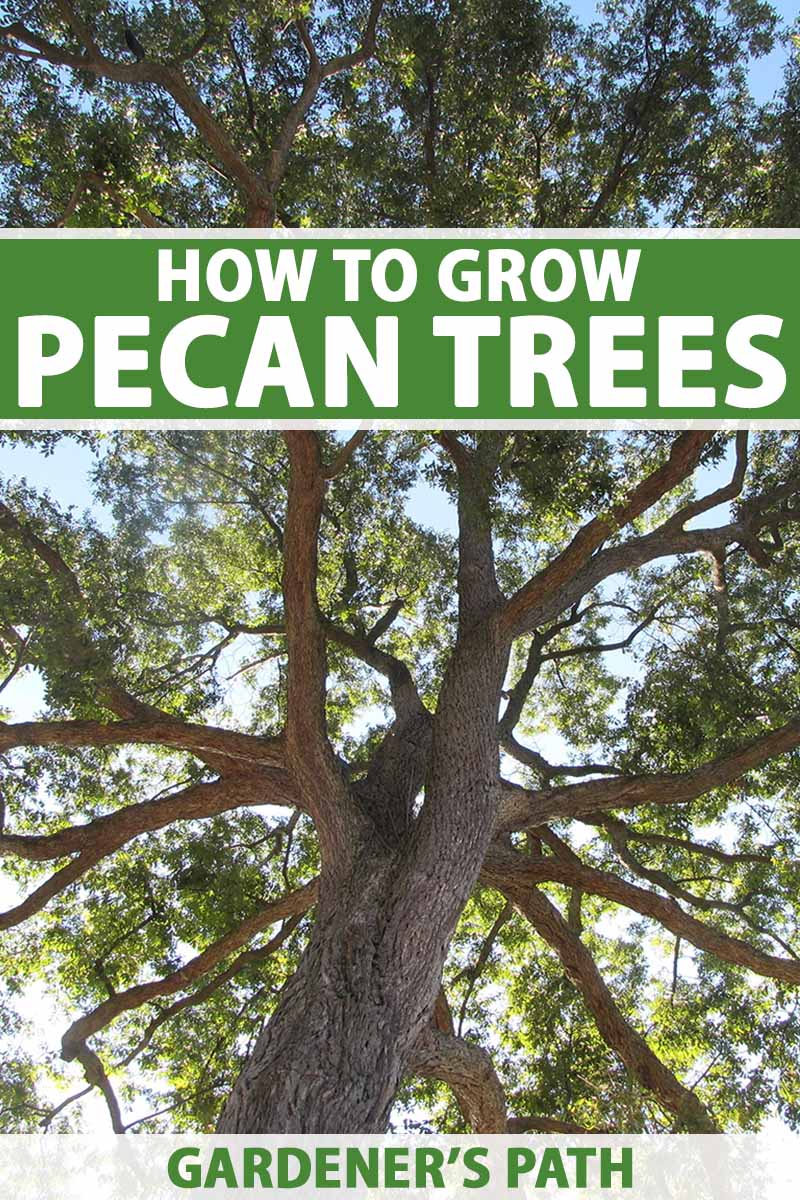
We link to vendors to help you find relevant products. If you buy from one of our links, we may earn a commission.
From my limited perspective as a tree nut enthusiast – albeit a zealous one – I’ve noticed that pecans are, for the most part, less popular than almonds, cashews, and pistachios.
Which is truly a shame, because I’ve found the pecan to have a buttery sweetness and texture-rich mouthfeel that many other nuts lack.
The trees themselves don’t receive the credit they deserve, either.
Despite their bountiful gifts, some people consider them a hassle, what with their dropping copious amounts of twigs, leaves, and husks every fall.
But if you can get over its litterbug tendencies, Carya illinoinensis will liven up your landscape with its beautiful leaves and overall form.
Whether you choose to grow it for its nuts, looks, or both, you’ll need some prior knowledge, useful tips, and helpful advice to ensure success. This guide will provide all of that and more.
Here’s what we’ll go over:
What You’ll Learn
What Are Pecan Trees?
A member of the Carya genus of hickory trees, C. illinoinensis is a large deciduous tree that’s best known for its tasty nuts.
Suitable for growing in USDA Hardiness Zones 5 to 9, pecans can trace their natural origins to wet lowlands in states across the midwest and southern United States, as well as Mexico.
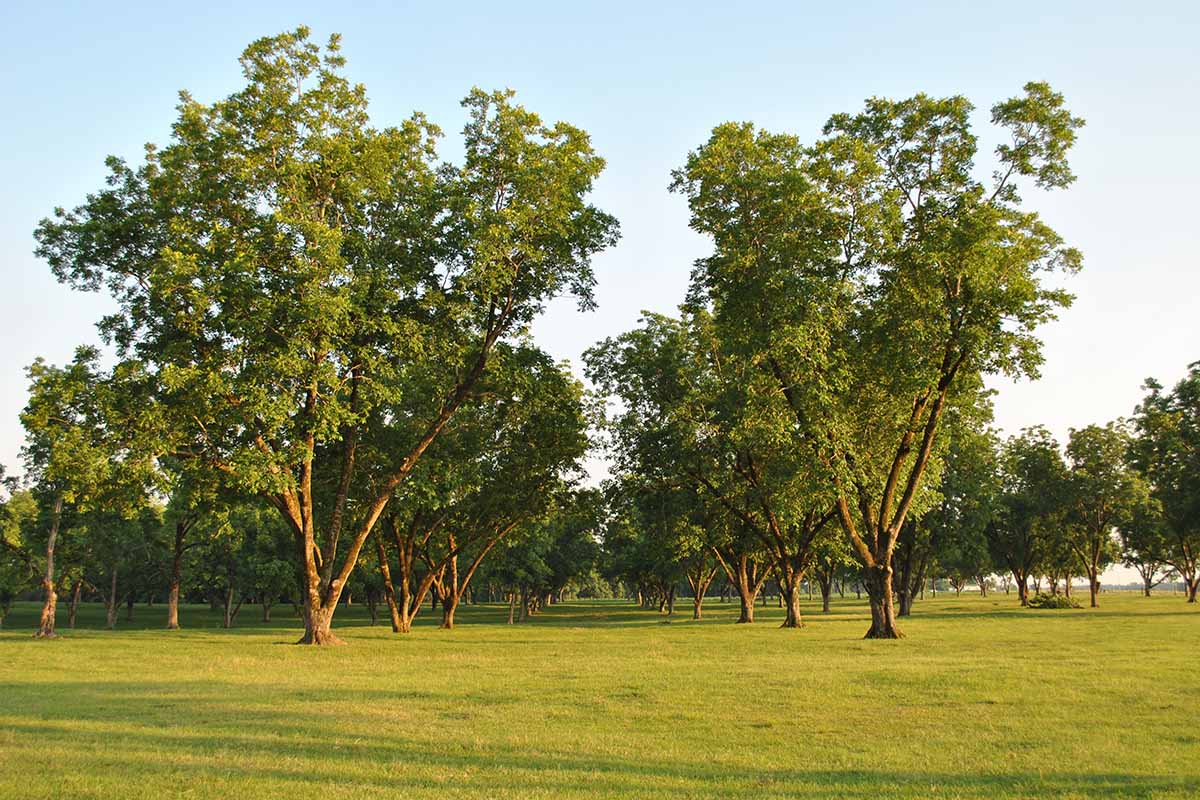
With a mature height of 70 to 100 feet and a mature spread of 40 to 75 feet, the pecan is the biggest of the hickories. The trunk bears ridged brown bark with gray flecks, and the crown has a beautifully rounded oval shape.
C. illinoinensis flaunts green, compound leaves up to two feet long, each with nine to 17 toothed, spearhead-shaped leaflets. Turning yellow in fall, the foliage is large and densely-packed enough to provide some nice shade from the sun.
As monoecious trees, all pecans produce male catkin blooms and female floral spikes of a greenish-yellow hue in mid- to late spring, neither of which are aesthetically significant.

If you want to ensure pollination, then definitely plant more than one, preferably of different varieties.
After being wind-pollinated, the female flowers will yield clusters of three to six yellow-green seed husks, which turn brown and split open into quarters after the seeds ripen.
Inside each lies an oblong nutshell with a light brown to reddish-brown hue. Inside of that lies the pecan kernel of legend, the one that goes great in pies and trail mixes.
As all members of the walnut family do, C. illinoinensis produces juglone, a toxic chemical that can poison nearby susceptible plants. When planting pecans, it pays to be mindful of the neighboring flora!
Cultivation and History
As the only major, commonly-consumed tree nut native to North America, pecans have been gathered and eaten by the continent’s natives for thousands of years.
We actually got the word “pecan” from the language of the Algonquin people, meaning “all nuts requiring a stone to crack.”
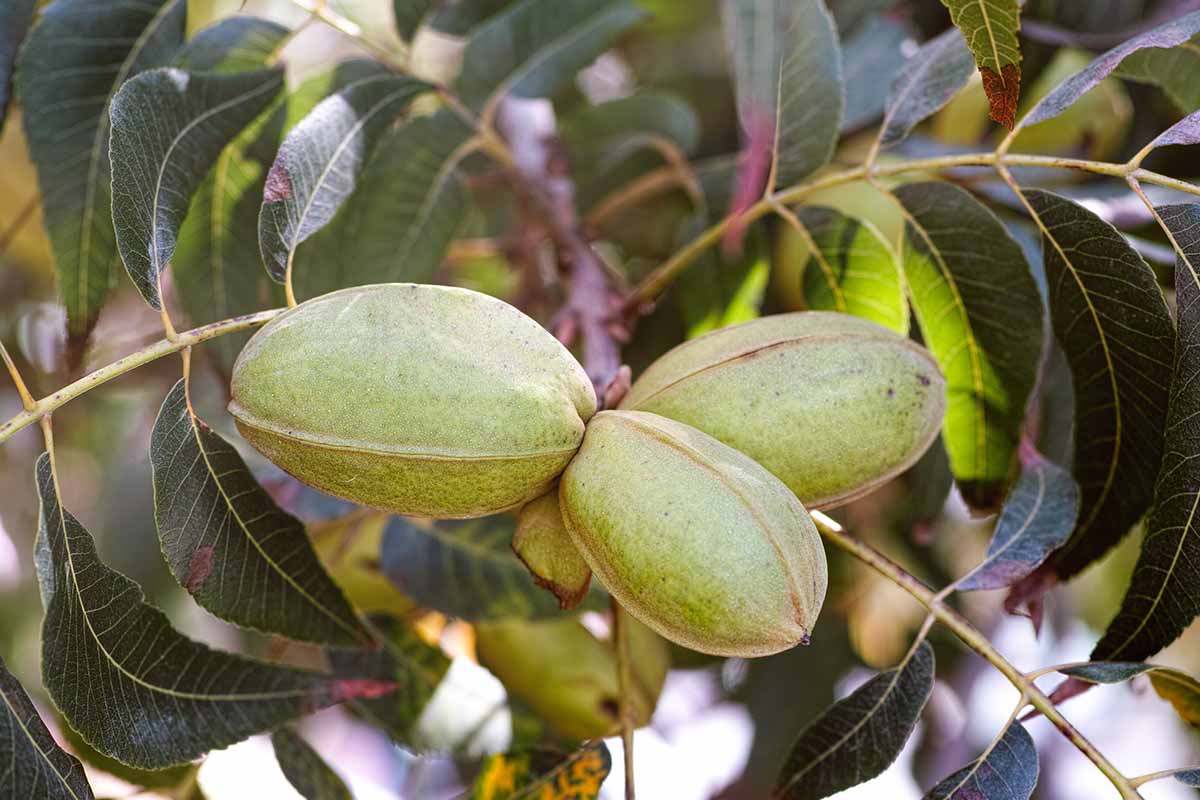
As a result of its strict nativity to North America, C. illinoinensis wasn’t discovered in the Old World until after explorers showed up in the 15th century and later brought the nuts back home with them.
In the late 1600s and the 1700s, European colonists started cultivating pecan trees, with specimens notably growing on the properties of US presidents George Washington and Thomas Jefferson!
By the early 1800s, the pecan trade had become a full-blown industry. For a while, seedling cultivation was the de facto method of growing pecans.
That is, until the notably successful grafting of the ‘Centennial’ cultivar in the mid-to-late 1800s, which led to the commercial propagation and improved production of pecans in the 1880s.
Advancements in the industry have continued ever since. Breeding programs have left modern-day growers with over 500 unique cultivars to choose from, and pecan pest management has remained an important and ever-evolving field.
The leader of a multi-million dollar industry, the US produces the majority of the world’s pecans – according to the USDA’s National Agricultural Statistics Service, American pecan production totaled 275 million pounds in 2022. That’s a lot of nuts!
And of course, folks love pecans for their taste and health benefits, whether consumed solo or as an ingredient in delicious recipes.
Pecan Tree Propagation
Are you nuts for pecans yet? To acquire some of your own, your best bets are to grow them from seed, graft or bud them, or straight-up transplant them.
From Seed
For commercial growers, this method is lacking. Seeds don’t grow true to type, so you could end up with a plant that’s different from its parent. If it ain’t broke, don’t fix it… especially if your livelihood depends on your pecan yields.
But odds are that you’re an amateur, with the time and freedom to play around with seed sowing. And who knows? You could end up growing a unique and trademarkable cultivar!
Step one: obtain seeds, either by collecting them from a tree in fall, or purchasing seed from a reputable vendor. Make sure the parent is a suitable cultivar for your area!
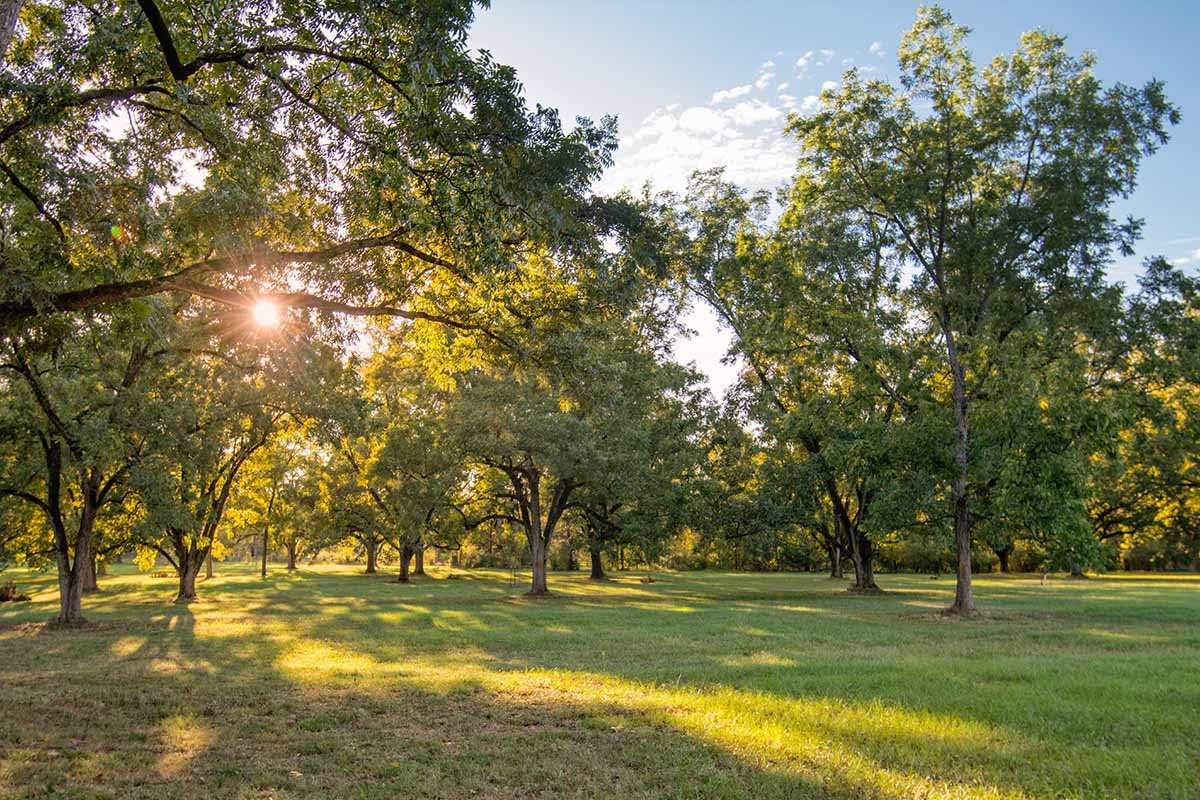
For fall seed collection, pick them up when they fall to the ground in October or November. Do this ASAP, before bugs or pathogens can harm the seeds.
Store the gathered seeds in a cool, dry place until the moisture of the kernels within is about five percent. You’ll know that the kernels are this dry if they snap when bent.
Place the whole, uncracked nuts in baggies filled with moist vermiculite, then stratify them in the refrigerator until after the last frost in spring.
At this point, remove the seeds from their baggies, rinse off any clinging vermiculite, then leave them soaking in running water for 24 to 48 hours to stimulate germination.
Soaking them outdoors in a bucket of water with a hose left running works perfectly.
After that, the seeds should be planted in brightly-sunlit, deep, and well-draining garden soil at a depth of one to one and a half inches.
Work a bit of compost into the planting site beforehand, and ensure that the soil pH is 6.0 to 7.0.
Water in the seeds, and keep the adjacent soil moist as they grow and develop. After two years of care and protection from animals, the saplings should be four to five feet tall.
Via Grafting/Budding
For seasoned pecan growers, grafting and budding are fast ways to create a clone of the parent plant.
Regardless of the method used, either entails combining the shoot tissue of a parent with desirable fruit, or a scion, with the roots and lower shoot tissue of a parent with other desirable qualities, or the rootstock.
When the union heals, you’re left with a true-to-type specimen that grows quick and yields exactly what you want it to, all the while sporting some pretty sweet traits such as disease resistance and climate hardiness.
Grafting and budding are what industry professionals use to consistently yield delicious nuts, but a full breakdown of these techniques is beyond the scope of this guide and the capability of its author. We’ll take a closer look at these techniques at a later date.
In “Star Wars” terms, consider this guide your Obi-Wan Kenobi, i.e. an effective teacher for the beginning of your journey. But to eventually learn the skills that’ll take you from amateur to expert, you’ll need to find your Graft Master Yoda elsewhere.
Via Transplanting
This tree has a deep taproot that can make transplanting tough and laborious. Hence, you’ll want to transplant saplings and juvenile graftlings, rather than more mature specimens with a longer taproot.
In late fall after leaf drop to early spring before bud break, prepare well-draining, deep, and fertile planting sites with a pH of 6.0 to 7.0.
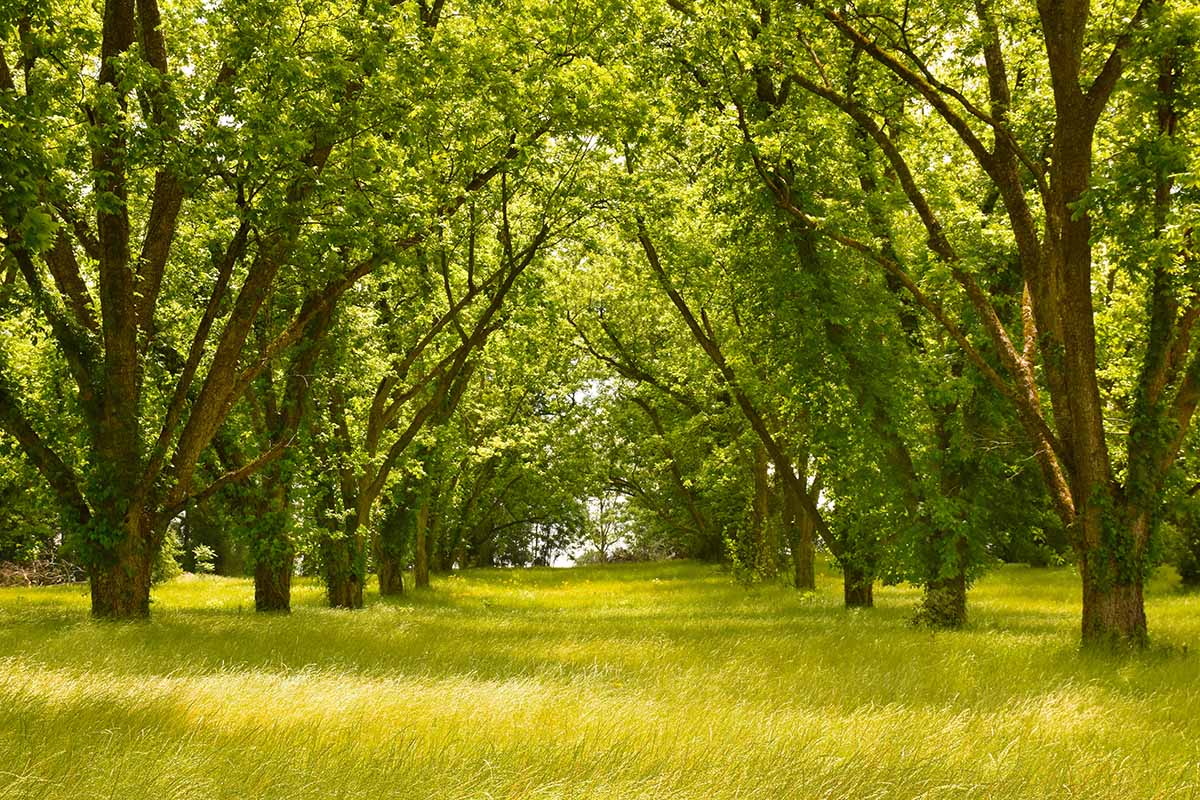
Space these sites at least 30 feet away from structures, and as far apart from each other as you’d expect the tree canopies to spread at full maturity. Dig the holes as deep as the root systems, and a bit wider.
You’ll need to soak the roots of bare root trees for three to six hours prior to planting, while container-grown ones should be lifted from their containers just before planting.
Place the tree in the hole, exposing the root flare above the soil and keeping any graft unions at least two to four inches above the soil line.
Fill half of the remaining empty space with soil, then water in. Fill the remaining space with soil, water that in well, and consider your trees transplanted.
To bring the roots and shoots of a grafted transplant into balance, you’ll want to lop off the top third of the tree upon planting… assuming that it hasn’t been done already, as is typically the case with nursery-grown specimens. Make sure to check first!
How to Grow Pecan Trees
Got a beautiful tree growing from the ground? Great! Let’s learn how to keep it that way.
Climate and Exposure Needs
The pecan is hardy in Zones 5 to 9… but not every garden in these climates can necessarily support it.

Pecans love the heat. According to William Reid, a former Pecan Research and Extension Specialist for Kansas and Missouri, pecans require warm summers with warm temperatures at night to ripen.
So, even though an area might be in Zone 5 based on its minimum average temperatures, that doesn’t guarantee its nights stay warm enough to grow pecans, according to Reid.
When in doubt, consult your local county extension agent to find out whether your area has the right climate for C. illinoinensis, as well as which variety will do best locally.
Regardless of climate, full sun is the best exposure – you won’t end up with primo nuts without ample sunlight!
Soil Needs
The best soil for a pecan is deep, with at least three feet of fertile and well-draining soil available. So barren, rocky areas with thin soil won’t work.
For fertility, add four pounds of a balanced fertilizer per inch of trunk diameter annually in March.

Try this 20-20-20 NPK fertilizer from Jack’s Classic, available in powdered form on Amazon.
Water Needs
Usually found along riverbanks in its native environment, the pecan likes a lot of water. Young trees need 10 to 15 gallons of water per week, whether from rainfall or from irrigation.
As they mature and begin producing nuts, they need about two inches of water per week throughout the growing season, applied at the drip line.
Growing Tips
- Full sunlight exposure is optimal for nut production.
- Provide deep, well-draining, and fertile soil.
- Mature, nut-producing trees need two inches of water a week during the growing season.
Pruning and Maintenance
Along with bountiful nuts, C. illinoinensis drops twigs, leaves, and the split-open seed husks.
For the sake of preventing infection, insect infestation, and a messy-looking landscape, these bits of detritus should regularly be raked up and composted, or at least disposed of.
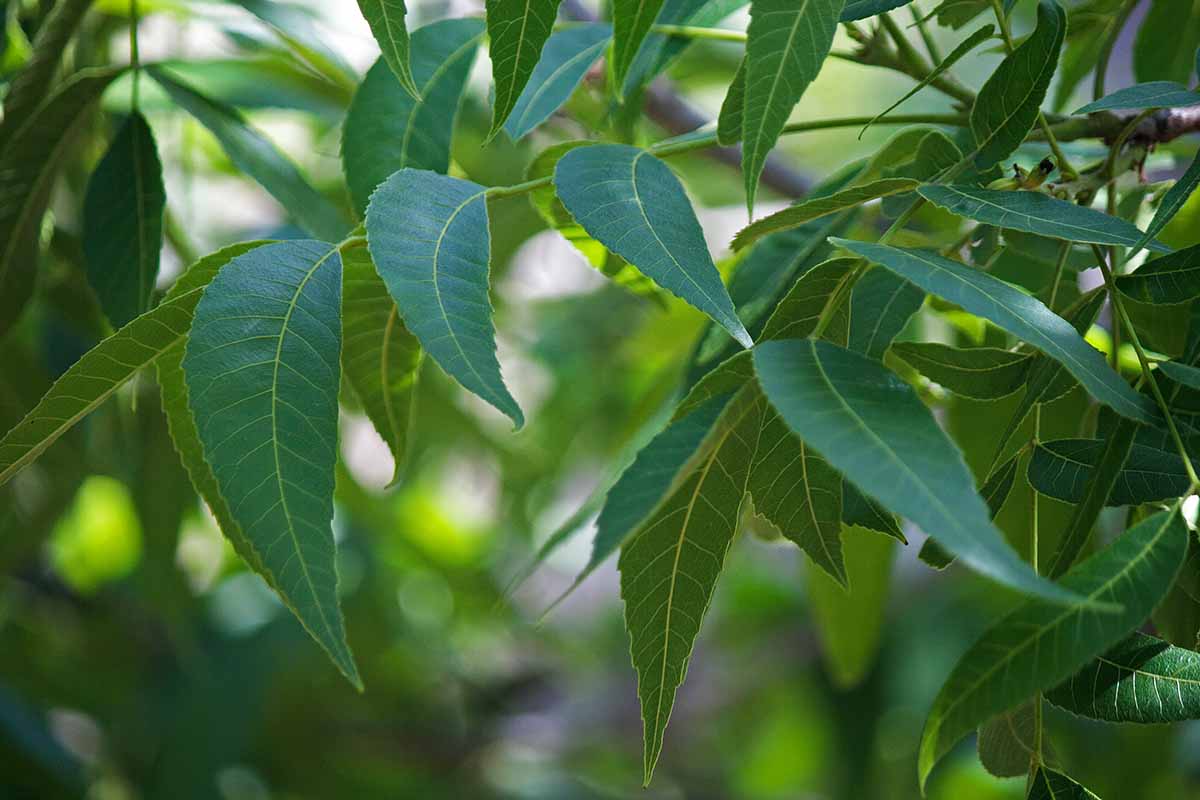
During a pecan’s juvenile years, early spring pruning to maintain a strong central leader is essential.
Little pruning is required after the tree reaches maturity, save for the prompt removal of root suckers and dead, diseased, or otherwise damaged branches.
Additionally, maintaining a few inches of mulch around the trunk will help to suppress weeds, maintain moisture, and protect the roots from harm. Plus, it looks real pretty.
Pecan Tree Cultivars to Select
As mentioned above, there are a gargantuan amount of pecan cultivars.

Therefore, we’ll be location-specific with our recommendations, and suggest certain varieties that are known to do well in certain states.
But, as far as quality recommendations go, nothing beats consulting your local extension office for the final word on what does best in your area.
Kansas-dwellers and Missourians, look for ‘Kanza,’ ‘Hark,’ or ‘Shepherd.’
Moving further south, ‘Amling’ does well in North Carolina, and Texans should have good luck with ‘Caddo.’
Mississippians should consider ‘Kiowa,’ while Georgian and Louisianan gardeners often plant ‘Elliott,’ which does well in Zones 6 to 9.
‘Elliot’ is available in two- to five-foot heights from FastGrowingTrees.com, and in #5 containers from Nature Hills Nursery.
If you’re located up north, ‘Pawnee’ might be for you. This cultivar has been known to produce high yields as far north as Rhode Island, Michigan, and Washington, and it’s good for Zones 6 to 9.
A bit smaller in stature, this type will grow to a mature height of 20 to 30 feet with a spread of 15 to 25 feet.
You can find ‘Pawnee’ available from Nature Hills Nursery in #5 containers.
‘Candy’ is another nice variety that’s known for reaching productive maturity sooner than other cultivars, and producing ripe nuts earlier in the season.
With a mature height of 50 to 70 feet and a spread of 40 to 50 feet, these also grow well in Zones 6 to 9.
Pick up ‘Candy’ at Nature Hills Nursery.
Finally, ‘Desirable’ is a cultivar that’s hard to resist, and it’s been a widely planted commercial favorite since the ‘60s.
This type grows quickly and it’s self pruning, so you’ll get giant clusters of large nuts faster than you might from other varieties.
Keep in mind that this one often reaches mature heights and spreads of 75 to 100 feet.
‘Desirable’ is available from Nature Hills Nursery.
Managing Pests and Disease
Herbivores, insects, and pathogens all want a go at your trees, so read on to learn how to keep your pecans safe.
Herbivores
As cute as furry and feathered critters are, their appeal wears off the second they start munching on crops. Here’s how to deter some of the top offenders:
Birds
An assortment of avian wing-flappers can eat the nuts from your trees, from turkeys to blue jays to crows.
But it’s not exactly “green” to go a-blasting with a 12-gauge. Depending on your property’s location and the bird in question, it may not even be legal.
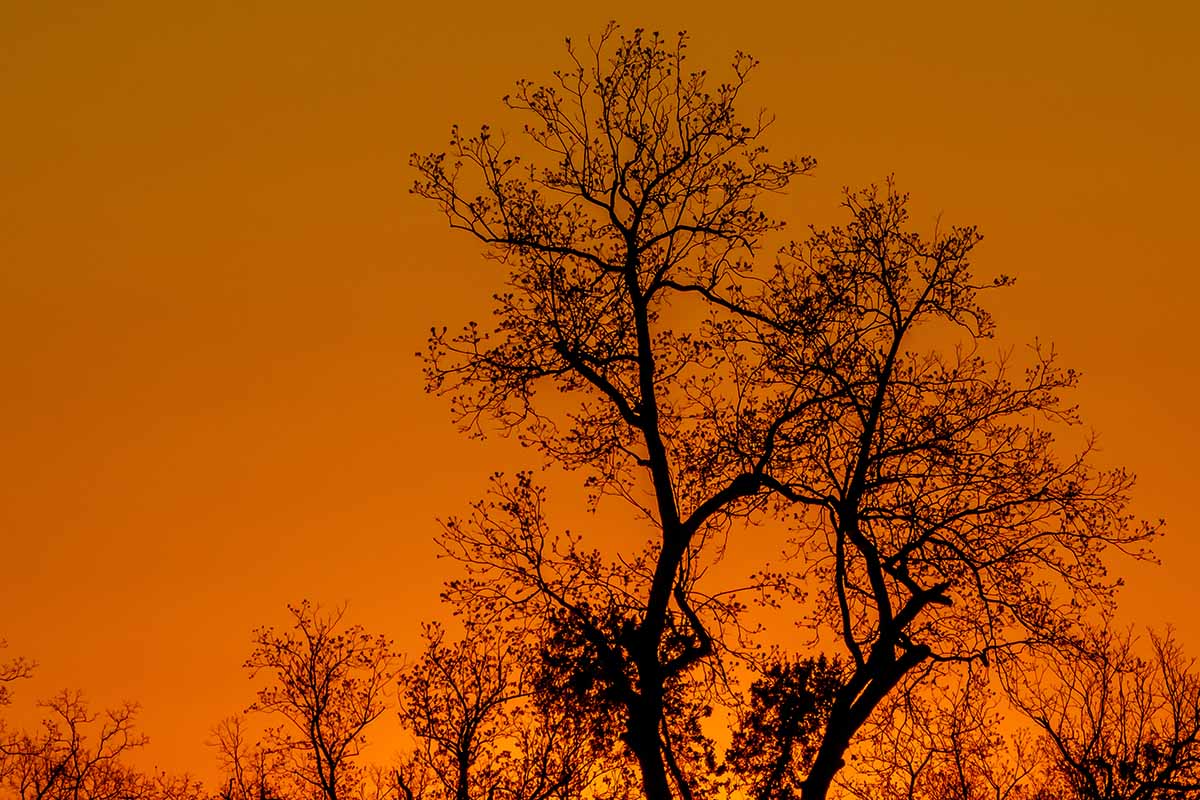
Therefore, you should opt for auditory and visual repellents. From sound machines to banging metal, and glittery tape to hawk kites, there are plenty of options.
The golden rule to remember is that while a lot of different repellents will work, nothing works forever. Thus, rotate what you use to keep birds guessing.
Deer
Notorious for eating just about anything, deer will definitely munch at your pecan trees.
Additionally, bucks can rub the velvet off their antlers with the thin trunks of young pecans, which damages the bark.
Along with using deer repellents, you can’t go wrong with a well-constructed deer fence that surrounds your property. Heck, it’ll come in handy for protecting your other plants that deer like to eat from as well.
Small Mammals
Squirrels, raccoons, and the tree-climbing like can all consume C. illinoinensis nuts with annoying efficiency.
Besides species-specific repellents, the key is to reduce the climbability of mature trees, which can be done with two to three feet of sheet metal wrapped around the trunks of susceptible specimens. Make sure to adjust the metal as the tree grows!
Insects
The especially irritating part about insects is their tendency to vector pathogens as they feed. But on the flip side – by controlling bugs, you’ll help prevent disease!
Fall Webworms
Wrapping cotton candy-esque webbing around tree branches, fall webworms are rather irritating pests.
Hyphantria cunea are black- to reddish-headed caterpillars about an inch in length, with yellow to green, black-striped bodies covered with white hairs.
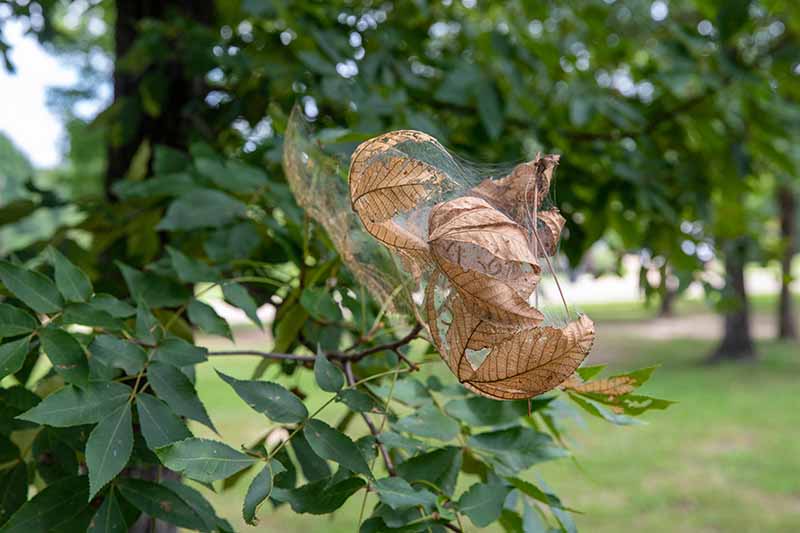
Overwintering in tree bark and nearby detritus, fall webworms can consume leaves to the point of near defoliation, which spells disaster for your eventual pecan-based desserts.
You could use contact insecticides, but since you’re trying to eat from the tree, that can be risky.
Along with promptly removing detritus, it’s best to manually break up and destroy webs when you see them with a stick, wire, or other lengthy rod.
Drop the webbing into a bucket of soapy water for the TKO.
Twig Girdlers
Adult Oncideres cingulata beetles have a grayish-brown body and long antennae, while the larvae are soft-bodied and white.
Both will girdle small portions of twigs, often reducing the aesthetics and yield of infested branches.
Preventative treatment usually isn’t necessary, but you definitely should remove and burn broken twigs, which can reduce twig borer populations.
Weevils
A significant pest of the pecan, Curculio caryae adults emerge from the soil in early fall, with their slender snouts and reddish-brown beetle bodies.
Traveling to a nearby tree, the adult females puncture a nut and lay eggs inside it, which causes the nut to fall prematurely from the tree.
Feeding within the nut, the larvae then leave, burrow in the soil, and pupate into adults. The cycle continues the following fall.
You should definitely be on the lookout for shells that fall prematurely.
Weekly sprays of carbaryl insecticides should be made from mid-August through mid-September in the case of confirmed infestation, while a paper trap wrapped around the trunk at a height of six feet or greater is a non-insecticidal alternative.
Disease
Since pathogens can easily spread, it pays to use sterilized tools, clean plant stock, and disease-free soils.
Anthracnose
A fungal disease driven by the spread of Colletrotrichum species – especially in rainy conditions – anthracnose mars leaves and nut husks with sunken, brown to black lesions, which puts a dent in nut yields and photosynthesis. The husks may also exhibit cream- to light pink-ringed spores.
Utilizing resistant varieties will help with prevention. If the disease is already present, infected plant parts should be removed and destroyed.
Powdery Mildew
With its trademark white powdery growth on infected foliage and nuts, powdery mildew in pecans is caused by Microsphaera alni fungi.
It causes the most damage in young nuts, to the point of causing stunted growth and their eventual demise. Thankfully, the disease doesn’t typically damage mature nuts.
Using resistant varieties is a solid way of preventing the disease. Pruning away severely infected tissues can further reduce spread.
Scab
Caused by the fungus Cladosporium caryigenum, scab infects young foliage and nut husks before they reach maturity, as well as developing twigs and male flowers on occasion.
Surviving on infected structures from the year before, the fungi produces spores in spring that spread via wind and water in moderate temperatures of 65 to 85°F.
Infected leaves will exhibit small, circular spots that darken, grow, and sink in with age, while infected nut husks will drop and crack, with ruined yields.
All infected structures will exhibit stunting, deformation, and vulnerability to other pathogenic infections.
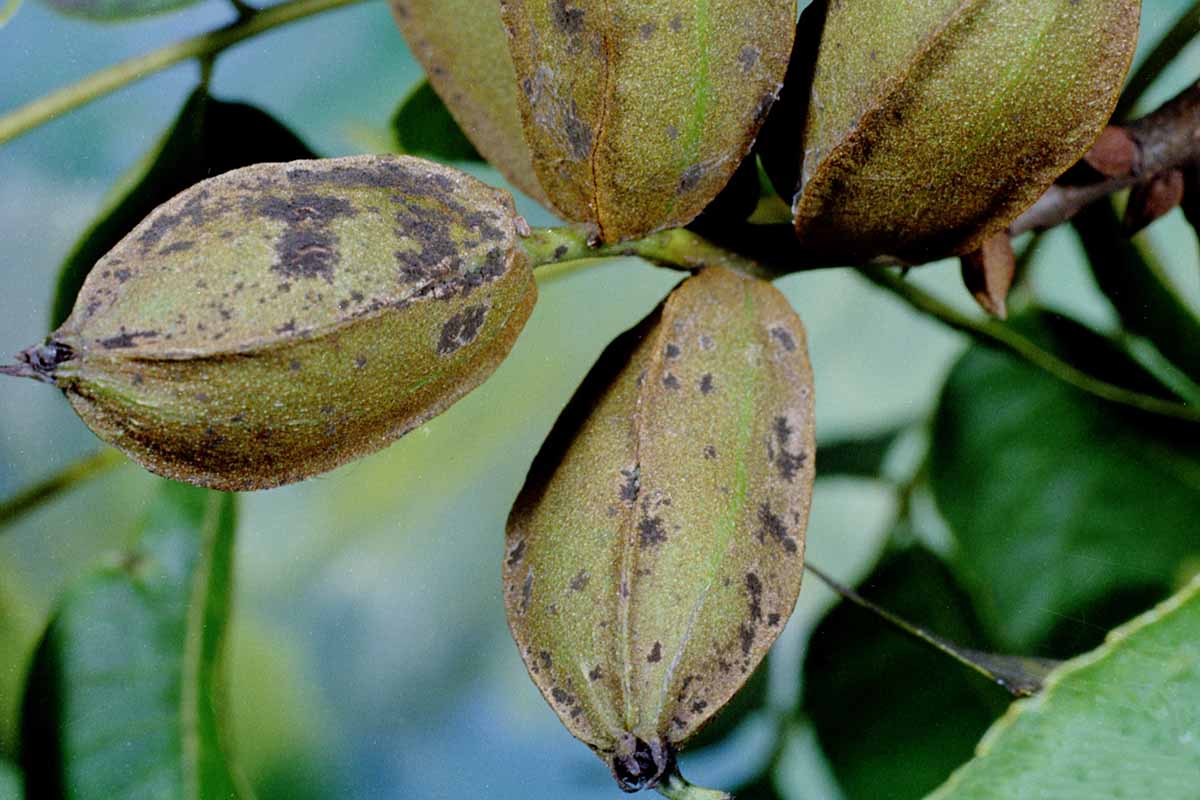
Planting scab-resistant varieties such as ‘Elliott,’ ‘Excel,’ and ‘Kanza’ is the best form of prevention.
A protocol of rotating at least three different fungicide sprays beginning at bud break and with a total of 12 evenly-spaced applications per growing season can help with prevention as well.
Additionally, you must remove and destroy infected leaves and husks before the fungi within can produce spores and spread further.
Stem End Blight
Caused by the fungus Botryosphaeria ribis, stem end blight is characterized by black lesions on the developing nuts, generally starting around the junction of the nut and the stem.
Spread by insects, this disease can wipe out your entire harvest.
You can learn all about this disease and how to prevent and treat it in our guide.
Twig Dieback
Another devastating disease that can infect your trees is twig dieback, caused by fungi in the Botryosphaeria genus.
Early symptoms include wilting branches and on closer inspection, the branches will have raised cankers, which are the fruiting bodies of the fungus.
Our guide to pecan twig dieback has more information and treatment options.
Harvesting, Curing, and Storing Pecans
“Enough talk! I’m STARVING!”
Touché. I mean, my mouth has been watering while I write this… it’s a miracle that I haven’t short-circuited my laptop.
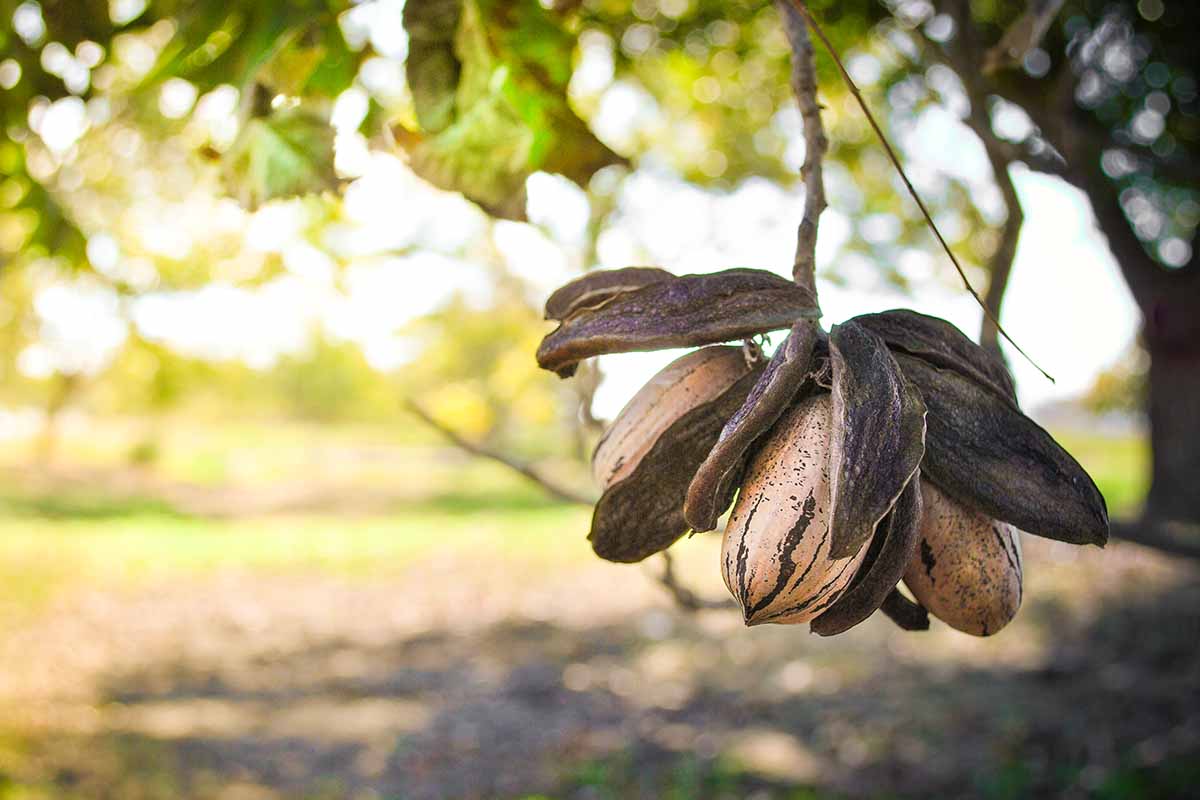
Depending on the variety in question and how it was propagated, a tree should start producing nuts in four to 10 years.
If your tree has reached nut-producing maturity, you should mow the grass and clean up fallen debris so you can better spot the ripe nuts when they drop to the ground in October or November.
In general, the nuts will ripen and fall over about a three-week period, so gathering them from the ground should be a daily task during this time.
You can use a rake or a small snow shovel to gather them, or pick them up with your hands.
To speed up the process with those nuts that are taking longer to fall, dislodge or shake them from the tree by hitting or shaking their branches. For the former, a large stick is the perfect tool.
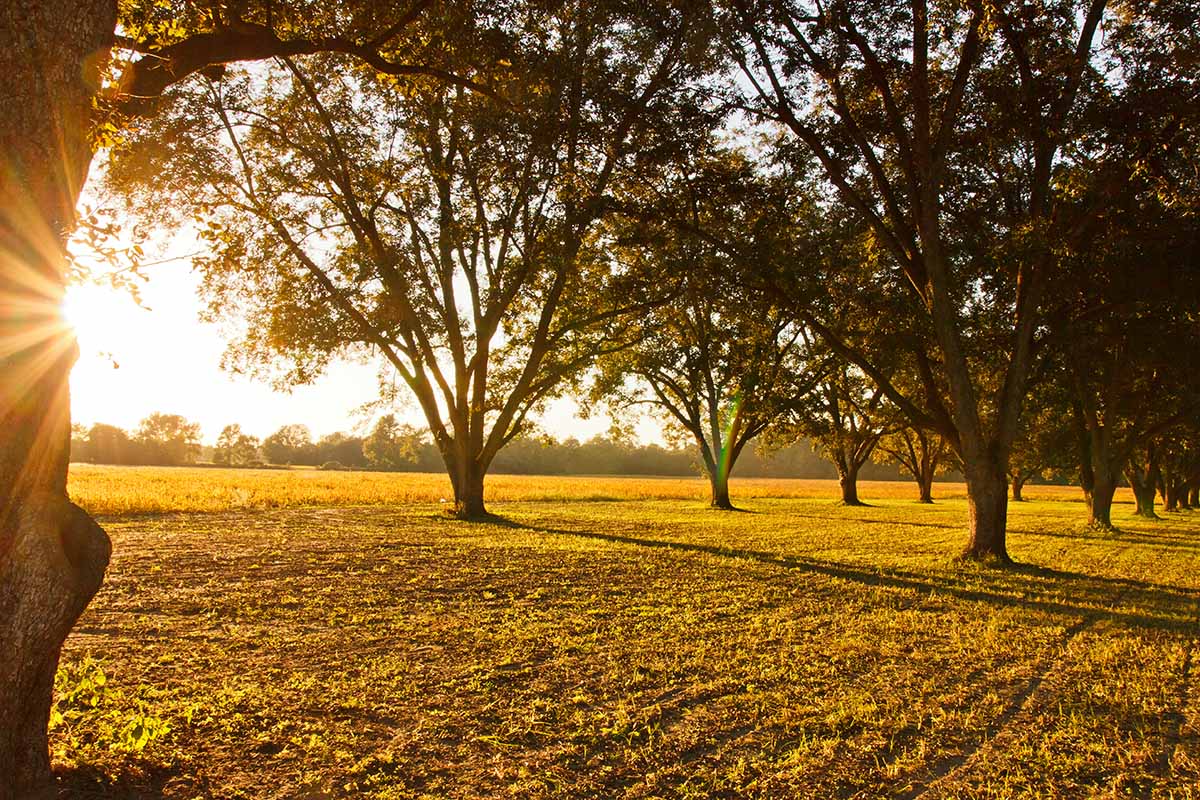
Have you gathered all of the nuts? Fantastic. Clean off any debris from their shells, and discard any that show signs of damage, infection, or infestation.
After a period of curing, the kernels within the nuts will be ready to consume.
Cure them by leaving the nuts in a dry spot with good air circulation for about two weeks, spread out on wire racks or trays in a single layer. If desired, you can easily increase the airflow by placing a fan nearby.
You’ll know that they’re cured and ready to consume if the shells are easy to break and the kernels snap crisply.
At this point, feel free to crack the shells to remove the kernels within unless you prefer to store them whole.
Once extracted, the kernels should be good for nine months in the fridge or two years in the freezer.
Refrigerated nuts should be stored in airtight containers, while freezer-stored ones should be kept in plastic baggies. And when thawed, your kernels should last for another two months at room temperature!
If you plan on keeping your kernels in the shells for a bit, they can actually be stored at room temperature for six to 12 months. Be sure to keep them in cool and dry conditions!
All of these durations are averages, though. Prior to their consumption or use in a recipe, always check your nuts for signs of decay such as a bitter taste or rancid smell.
Best Uses for Pecan Trees
Whether eaten by themselves or utilized in delicious recipes – such as those provided by our sister site, Foodal – pecans are a healthy and tasty treat.
Selling your yield could be a fun side hustle, while sharing it free of charge will definitely up your popularity in your social circles.
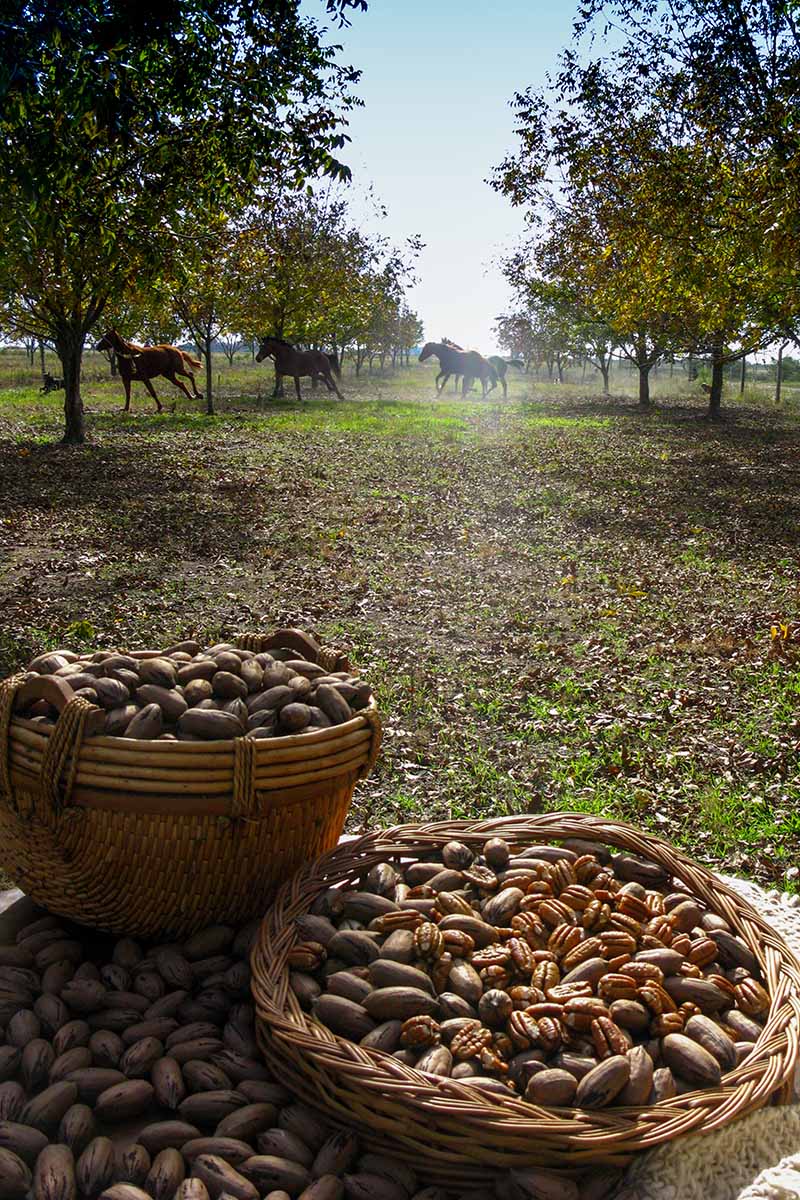
The nut husks can also be used in smoking meats, and making organic fertilizers and mulches.
And although C. illinoinensis is not usually grown solely for its appearance, the tree’s pretty leaves and form are certainly fringe benefits.
Quick Reference Growing Guide
| Plant Type: | Deciduous nut tree | Flower/Foliage Color: | Greenish yellow/green |
| Native to: | Midwestern to southern United States and Mexico | Maintenance: | Moderate |
| Hardiness (USDA Zones): | 5-9 | Tolerance: | Heat, juglone |
| Bloom Time/Season: | April to May | Soil Type: | Fertile, deep |
| Exposure: | Full sun | Soil pH: | 6.0-7.0 |
| Time to Maturity: | 4-10 years (seed production), 20 years (full size) | Soil Drainage: | Well-draining |
| Spacing: | Width of mature spread | Attracts: | Birds, deer, small mammals |
| Planting Depth: | 1-1.5 inches (seed), depth of root system (transplants) | Uses: | Nut production, ornamental orchards, smoking meat |
| Height: | 70-100 feet | Order: | Fagales |
| Spread: | 40-75 feet | Family: | Juglandaceae |
| Water Needs: | Moderate to high | Genus: | Carya |
| Common Pests and Diseases: | Beetles, carpenter worms, cankerworms, flea weevils, leafhoppers, sawflies, scale; black leaf spot, Botryodiplodia canker, Dutch elm disease, elm yellows, leaf scorch, stem end blight, twig dieback, root rot, wetwood | Species: | Illinoinensis |
“Nut Too Shabby!”
That’s what you could humorously say to yourself after a successful yield. If your loved ones are quick to roll their eyes at your puns, then you should definitely say it.
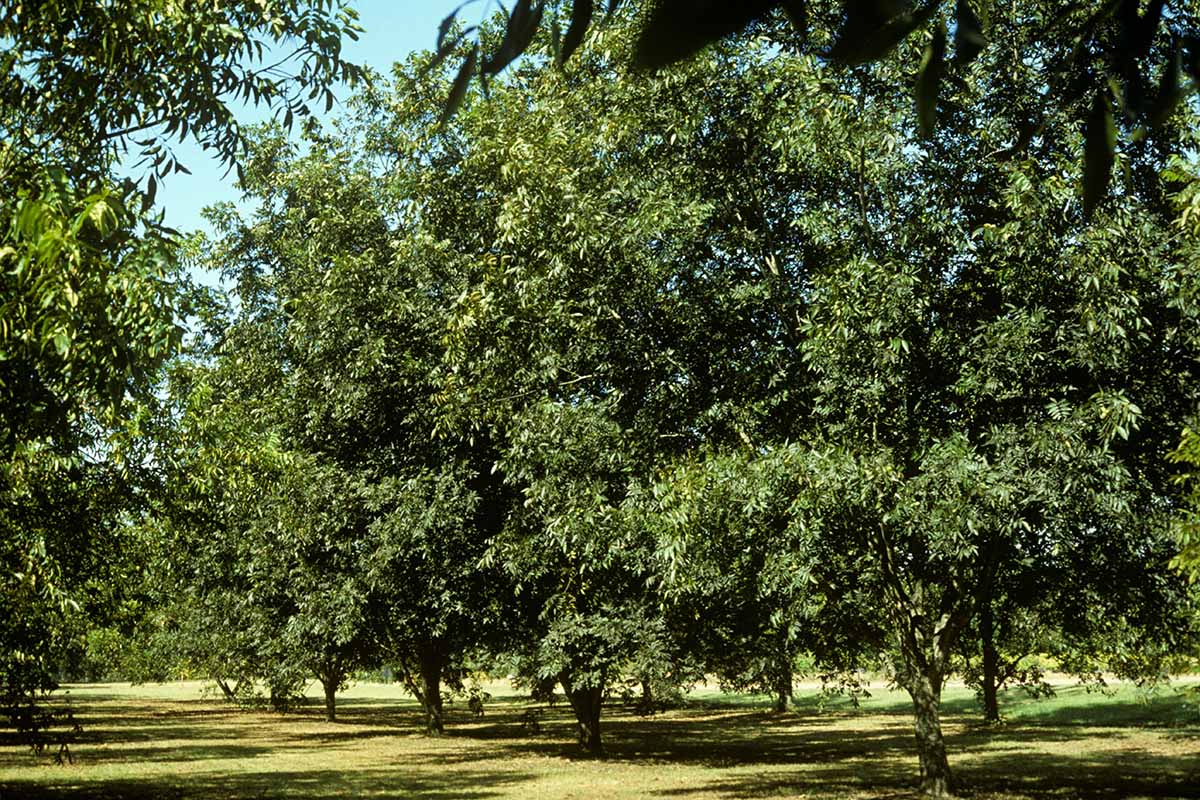
Like most things in life, pecan tree cultivation takes time and effort. But after putting in the work, you’ll be rewarded with one of the most delicious delicacies that nature has to offer.
Do you have pecan or other nut trees in your landscape? Share your experience in the comments section below.
Need a new variety of homegrown nuts for your trail mix? Get a taste of these tree nut growing guides:
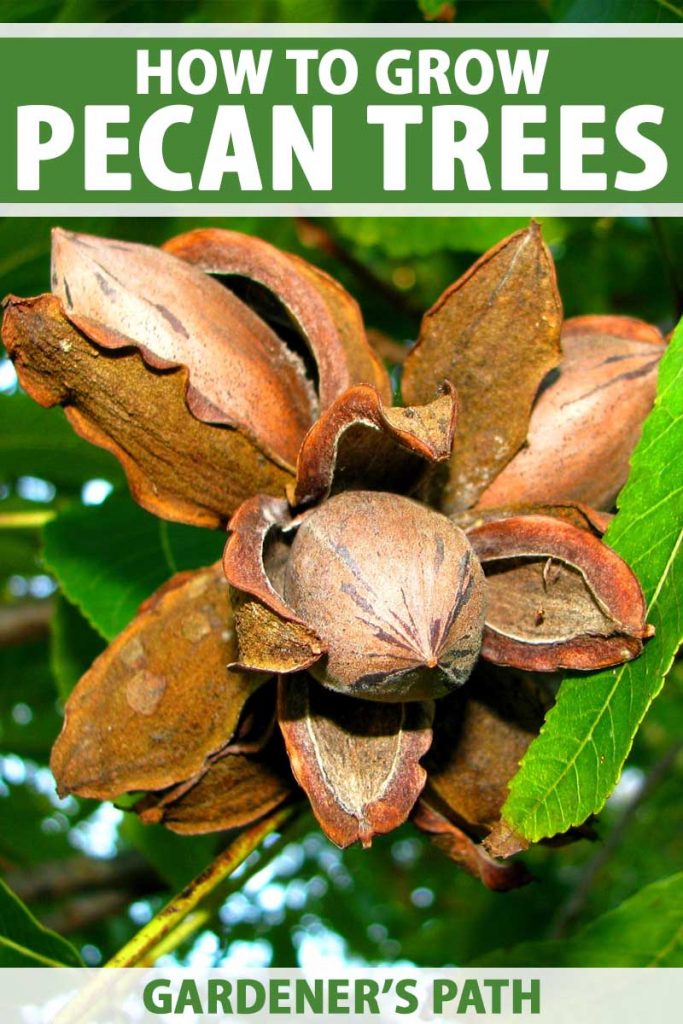
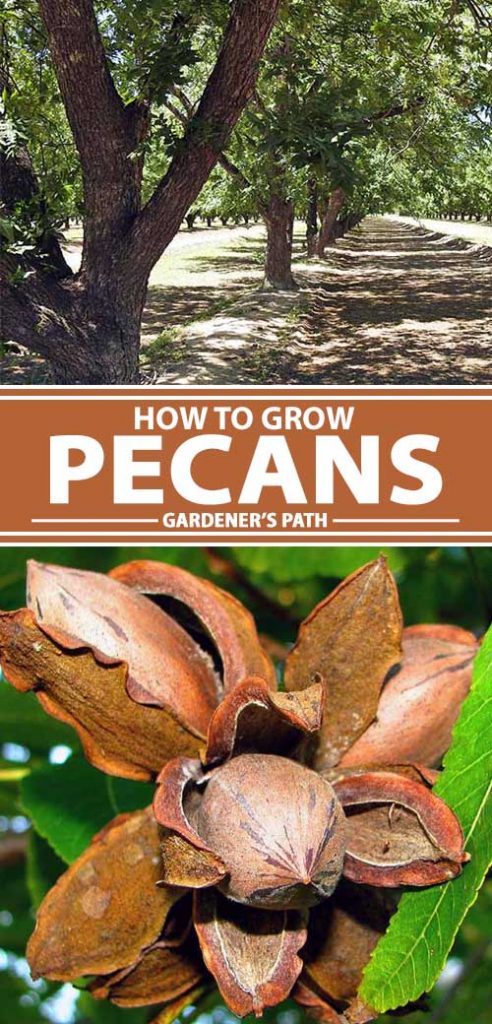

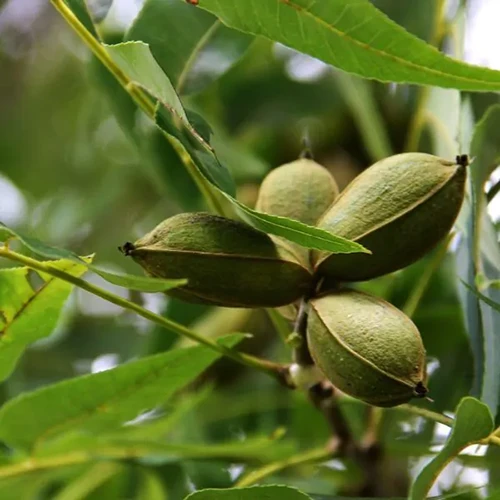
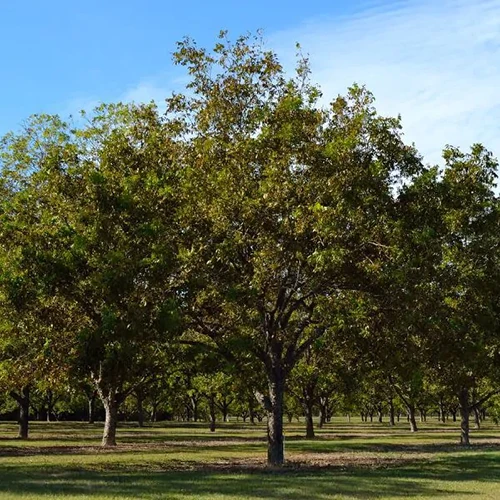
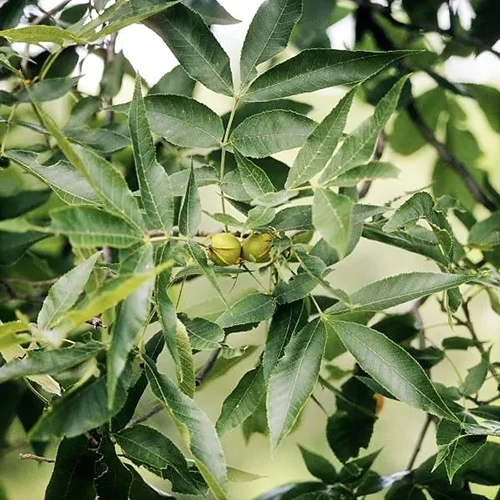
You are so right on the pronunciation of puh-KAHN! I get mad when I hear someone say PEE-can! This article is very interesting & I enjoyed the article on pruning crape myrtles. (I agree with the spelling of crape also!) If I need to learn something about trees & pruning, now I know what website to go to! Thank you so much!
Thanks, Cheryl, for your kind words! Funny thing… I was in Philadelphia this weekend for my son’s lacrosse tournament. I heard a commercial on the TV for a national chain of restaurants and they said PEEcan. I thought to myself that they must have to record two versions of the voiceover because I know they say puhkahn on the ads that air down here!
I enjoyed reading this article. I do have a question, though. I have a large pecan tree in my back yard. A wind storm early this fall broke a good sized limb. The limb didn’t come off completely. Since it had a large number of pecans on it which weren’t ready to harvest, I didn’t finish removing the limb. I noticed a week or so after it fell that it was putting out new leaf buds. So, I am wondering if the broken branch can be soaked in rooting hormone and rooted. The broken limb is about 2 to 2.5… Read more »
Thanks for getting in touch, Ann. You may have some luck rooting softwood cuttings in the spring, or you may want to try right away, particularly if you’re set up to start your cuttings indoors. With sterilized pruners, take 6-inch cuttings at a 45 degree angle about an inch below a leaf node, and remove all leaves from your cuttings except a few at the very tip of each. Scarify the bottom couple inches of the cuttings a bit, dip in rooting hormone, and gently tap off the excess. Stick your cuttings into a rooting medium or sterile potting mix… Read more »
This is our Southern California Pecan 60-75ft tall. In 30 years we have not gotten a single pecan from it. Just as they are coming to fruition dozens of four footed friends start to scramble all over it, for weeks raining husks onto our roof. Oh well, we have very fat squirrels every winter! ????
Thanks for reading… what a beautiful tree! I hear you about the &^%$# squirrels! If you’ve read some of my other articles about produce-bearing plants, you know what I think about these little rodents! Speaking of which, it’s about time for me to go check the fig tree and see if I can beat the 4-legged thieves to those fruits!
Thanks for your article, My question, I have several pecan trees in the backyard. The last couple of years, I’ve had good bloom and the looks of a good crop, until the last of June into July. the trees shed most of there nuts. Help. Live in the Texas panhandle
Hi Gary! Thanks for visiting us here at Gardener’s Path. Are you saying that the trees are dropping the husks with underdeveloped or unripe pecans inside? Have you had drought up there?
What about squirrels? I have a tree of great pecans but they knock them down while still green and eat a lot!!
Sandra, don’t even get me started on squirrels!!! Hahaha! Those fluffy, greedy rodents make me nuts! Not sure there’s much we can do about them, though!
Really? Who cares how folks pronounce it. Just eat them 😆
Haha! I suppose you’re right, djukester! What really matters is the eating, right? Thanks for reading!
Our pecan tree ruins everything in sight when the pods start falling. The patio is stained and the table along with the chairs. My question is, can you cut the part that houses the pecan pods off without killing the tree itself?
Hello Colrain – If you’d rather dispose of the nuts than harvest them for eating, you may be inclined to want to prune off the nut-bearing branches. However, this could damage your tree. Pruning is best done in late winter. However, to be rid of nut-bearing branches, you would have to do it in summer or fall. Unfortunately, pruning at these times may prove detrimental, as a flush of growth during heat, or one as dormancy begins, is likely to cause undue stress, and may render the tree vulnerable to disease. Instead, you may harvest the nuts as neatly as… Read more »
How long do the “squiggles” fall? We have four trees and they are inundating our yard and deck. Do they mean we will have a good crop or none?
Hi Betty! Thank you for your question. By squiggles (love the name), I’m guessing you’re referring to the catkins? These are the pollen-filled male flowers falling from the trees, and the good news is that if you have four trees, there’s a good chance you’ll have a nice crop of pecans, especially if you planted four different varieties. The reason is this: wind-pollinating pecans produce male and female flowers at different times and in different locations on the tree, meaning that one tree cannot pollinate itself. Some varieties of pecan trees mature the male flowers first. These are called protandrous,… Read more »
I just today discovered a pecan tree in our park! Also a chestnut I believe. When the pecan pods have cracked and nut pods are exposed, do I need to do anything to them before eating? Or are they edible off the tree? I brought a couple in to investigate what I found.
What a wonderful find, Denise! Pecans are ready to harvest when the green hulls split, and they can be collected off the ground. Look for nuts with intact brown shells, and discard any that show signs of rot. You can crack and eat them right away! If you plan to store them, they will need to be dried or cured in some way, or you can crack them and store the meat inside in zip-top bags in the freezer. Raw pecans are delicious, or you can roast shelled nuts in a frying pan or in the oven- just be sure… Read more »
We are about to purchase property and build a house on a lot with a gorgeous huge old pecan tree in the front corner. I want to prune the low branches and insist the builder find a way to build around it and save the tree but my husband says laying the foundation right next to the tree will be too much for the root system and we’ll lose it anyway. Thoughts? Any chance a pecan tree is sturdy enough to survive? Are the roots widespread?
While Scranton, pa exists because of coal with mine subsidence like a Centralia, Pa, there’s neighborhoods where the houses were leveled because those born in civilization don’t put up with subsidence. At any rate, I like boron as borax, that trace minerals like manganese are on the side of miracle gro because a molecule of B12 has an atom of cobalt, with Boron as borax trees that grow in fields in Pennsylvania (black locust) can put on thirty feet in a single year. One might have to add some 10-10-10 or some copper sulfate. A red clover has leaves the… Read more »